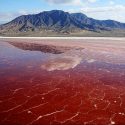Intense rainfall. Winds of 120 km/h (75mph) or higher. Storm surge. These are the signs of a hurricane.
During its reign of terror, a hurricane can release as much energy as 10,000 nuclear bombs. And guess what? There are two of them. And they’re on a collision course.
Meet Dr. Sakuhei Fujiwhara, the Japanese meteorologist who first defined the interaction between two hurricanes. The Fujiwhara effect describes what happens when two whirling weather systems, called cyclonic vortexes, come close enough to each other. Cyclonic vortexes could be hurricanes or typhoons. And if they get within about 1,000 km (620 mi) of each other, they can be even more dangerous.
It doesn’t occur very often, but it does happen. And some scientists believe that it will happen more often as global temperatures continue to rise.
The term hurricane gets its name from Huracan, known in Mayan mythology as a god of wind, storm, and fire. And you’re about to see why.
Hurricanes, or typhoons, form when warm, moist air over the ocean rises, and nearby air takes its place, forming swirls of air. As the warm, rising air cools, it makes huge clouds filled with moisture. These clouds continue to spin and expand, causing intense rain, wind, and surging tides wherever the storm goes.
Hurricanes can be extremely costly, both in material damages and in human lives. So how much more devastation can we expect when two hurricanes collide?
You might be looking up at two approaching storms and think to yourself, “That can’t be good.” And you’d be right. But how bad things are about to become for you really depends on how big the storm is.
If two hurricanes are about the same size and strength, they’ll do a “dance” and orbit around a common center. The result of this “dance” might send both storms off in different directions. They could be catastrophic for any city or region that wasn’t prepared for a hurricane.
But if one of the hurricanes is bigger than the other, the larger one can absorb the smaller one. This wouldn’t create some kind of megastorm like you see in the movies, with astronomical wind speeds and storm surges that wipeout whole cities. But two hurricanes combined could still make the hurricane stronger and longer-lasting.
Hurricanes are the most deadly storms. So increasing their strength can have a massive impact on people’s lives, on the economy, and on healthcare systems whenever they hit populated areas.
Hurricane Katrina was the costliest hurricane to hit the U.S. so far, and that was only a category 3 storm. A climatologist at the Massachusetts Institute of Technology, Kerry Emmanuel, believes that wind speeds in a hurricane could increase by about 5% for every 1°C (1.8°F) increase in tropical ocean temperatures.
A category 5 storm has winds of 252 km/h (152 mph) or stronger. Will we one day have to classify a category 6 storm?
Let’s hope not. But there are other reasons why we should try to keep the Earth’s temperature from rising. Do you know what would happen if all the world’s ice melted?
Subscribe to What-If on YouTube or follow the show on Facebook Watch.
Sources
- “Hurricanes: The Greatest Storms On Earth”. 2020. earthobservatory.nasa.gov.
- “What is storm surge?”. 2020. oceanservice.noaa.gov.
- “Fujiwhara effect”. 2020. en.wikipedia.org.
- “Huracan”. 2018. en.wikipedia.org.
- “What is the difference between cyclone, hurricane, tornado and twister? – Times Of India”. 2020. The Times Of India.
- “How Strong Can A Hurricane Get?”. livescience.com.
- “Hurricane Statistics Fast Facts”. CNN.
- “10 Facts About Hurricanes: Nature’S Deadliest Storms”. 2020. cbc.ca.

















